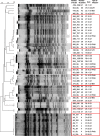Impact of tooth brushing on oral bacteriota and health care-associated infections among ventilated COVID-19 patients: an intervention study
- PMID: 36890608
- PMCID: PMC9992909
- DOI: 10.1186/s13756-023-01218-y
Impact of tooth brushing on oral bacteriota and health care-associated infections among ventilated COVID-19 patients: an intervention study
Erratum in
-
Correction: Impact of tooth brushing on oral bacteriota and health care-associated infections among ventilated COVID-19 patients: an intervention study.Antimicrob Resist Infect Control. 2023 May 29;12(1):51. doi: 10.1186/s13756-023-01256-6. Antimicrob Resist Infect Control. 2023. PMID: 37248538 Free PMC article. No abstract available.
Abstract
Background: Up to 48% of ventilated coronavirus disease 2019 (COVID-19) patients develop ventilator-associated pneumonia (VAP) during hospitalization in an ICU. Dysbiotic oral microbiota can colonize the lower respiratory tract and lead to VAP. It is recommended to introduce oral care strategies in the ICU to prevent VAP. In this study, we observed the impact of an oral hygienic protocol with tooth brushing on cultivable oral bacteriota, the incidence of HAI and patient safety among mechanically ventilated COVID-19 patients in an ICU setting.
Methods: In this prospective cohort study, we recruited 56 adult COVID-19 patients who qualified for mechanical ventilation. Patients were divided into 2 groups depending on the oral care procedure: standard and extended oral procedures with tooth brushing. Oral bacteriota samples were taken first within 36 h and after 7 days of intubation. Microorganisms were identified by MALDI/TOF mass spectrometry. bacterial health care-associated infection (HAI) cases were retrospectively analyzed by etiology. A PFGE study was performed for Klebsiella pneumoniae to check for clonal spreading of strains from oral bacteriota samples and HAI cases.
Results: We observed significant dysbiosis and a decrease in cultivable oral bacteriota diversity, with a high frequency of potentially pathogenic species, including Acinetobacter baumannii and K. pneumoniae. The HAI incidence rate was high (55.2/1000 patient-days), most commonly of K. pneumoniae and A. baumannii etiologies, which correlated with the presence of A. baumannii and K. pneumoniae in the oral samples. Strains isolated from VAP cases were the same as oral isolates in 8 cases. The procedure with tooth brushing led to less frequent identification of A. baumannii in oral samples (55.6% vs. 5.3%, p = 0.001); however, it did not decrease the incidence of HAIs.
Conclusions: Dysbiotic oral bacteriota is an important source of respiratory pathogens. The introduction of tooth brushing in oral hygiene protocols in an ICU setting was effective in decreasing the extent of oral bacteriota dysbiosis; however, it did not reduce the risk of HAIs or mortality.
Trial registration: 1072.6120.333.2020.
Keywords: ARDS; COVID-19; Dysbiosis; HAI; Health care-associated infection; Mechanical ventilation; Oral microbiota; VAP; Ventilator-associated pneumonia.
© 2023. The Author(s).
Conflict of interest statement
The authors declare that they have no competing interests.
Figures

References
-
- Fiema M, Wlodarczyk A, Wojkowska-Mach J, Garlicki J, Gregorczyk-Maga I. Atypical presentation of Aspergillus niger infection in the oral cavity as a prediction of invasive pulmonary aspergillosis in a patient with COVID-19: case report and literature review. Microorganism. 2022;10(8):1630. doi: 10.3390/MICROORGANISMS10081630. - DOI - PMC - PubMed
Publication types
MeSH terms
LinkOut - more resources
Full Text Sources
Medical

